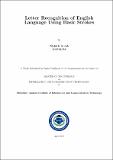Please use this identifier to cite or link to this item:
http://drsr.daiict.ac.in//handle/123456789/673| Title: | Letter Recognition of English Language Using Basic Strokes |
| Authors: | Roy, Anil K. Kotak, Nishith |
| Keywords: | Gesture Recognition Novel Biometric Smart Pen Device Mobile Phones Writing Errors Gyropen Gesture Vocabulary Self Correcting Pen Architecture |
| Issue Date: | 2017 |
| Publisher: | Dhirubhai Ambani Institute of Information and Communication Technology |
| Citation: | Nishith Kotak(2017).Letter Recognition of English Language Using Basic Strokes.Dhirubhai Ambani Institute of Information and Communication Technology.viii, 48 p.(Acc.No: T00635) |
| Abstract: | "In the recent era, perfection is an essential entity that de nes the work of a person and the determination of an individual towards his work. It is the most important aspect to draft the tasks carried out and form a document that speaks the e orts of an individual. Thereby, for a perfect documented work or even for the formal written communication, person must reduce the literature mistakes, i.e., spelling mistakes, grammatical errors, punctuation mark misplaced, etc. This practice of improvement like knowing the correct word spellings can be inculcated into the person from his childhood days, when he can grasp maximum knowledge thrown onto him. A child is always casual for the mistakes to be corrected and thereby, as a gen-eral practice, whenever the teacher of a subject corrects the spelling of the word given in his homework, he often doesn't bother to look into it and repeats the same mistake until he is made to remember the correct spelling of that word. Hence, it would be a good practice, if he/she is suggested the correct word spellings on the real time while writing. This will instantaneously pinch the child regarding his wrong spelling and the child will be advised to correct it. The system must be made smart enough to recognize the word and display the correct spelling of the word, just as the messaging application in our smart phone usually points out the correct spelling. Hence, a training-less system is required to be developed that is capable of rec-ognizing the word in the real time and make the suggestions to the child regarding the wrong word and thereby, contributes to the improved literature of a child. A sensory system needs to be placed near the tip of the pen that detects the acceler- ation, direction of motion and the curl of the rotation of the pen when the user is writing on paper, and the dictionary helps in decoding the correct spelling of the word. As a part of the rst step to this long de nition, an analysis of the raw data was done and the successful calibration of this data was carried out using Kalman Filter to make the data more sensible. We have implemented an e cient algorithm for the detection of the capital letters of English Alphabets and based on the waveform analysis, the features are extracted from the same. The system gives the accuracy of 89% while implementation of the basic four strokes and resulted into detection of 16 capital letters out of 26 in the English literature. The system identi es 85% of the letters successfully. In order to increase the accuracy of determining the letters, the mapping algorithm have been implemented along with the stroke detection algorithm. This leads to the increase in accuracy over 96% out of the total 800 observations that have been carried out." |
| URI: | http://drsr.daiict.ac.in//handle/123456789/673 |
| Appears in Collections: | M Tech Dissertations |
Files in This Item:
| File | Description | Size | Format | |
|---|---|---|---|---|
| 201511056.pdf Restricted Access | 201511056 | 3.75 MB | Adobe PDF |  View/Open Request a copy |
Items in DSpace are protected by copyright, with all rights reserved, unless otherwise indicated.
